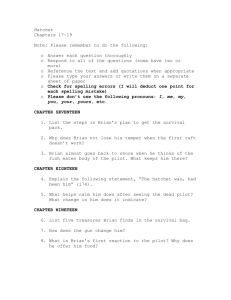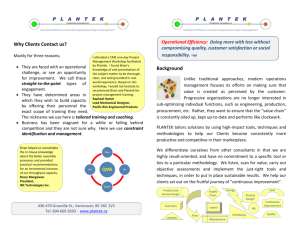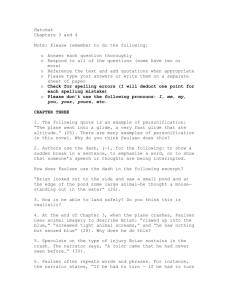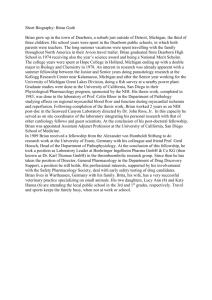Time Use - Panel Study Income Dynamics
advertisement
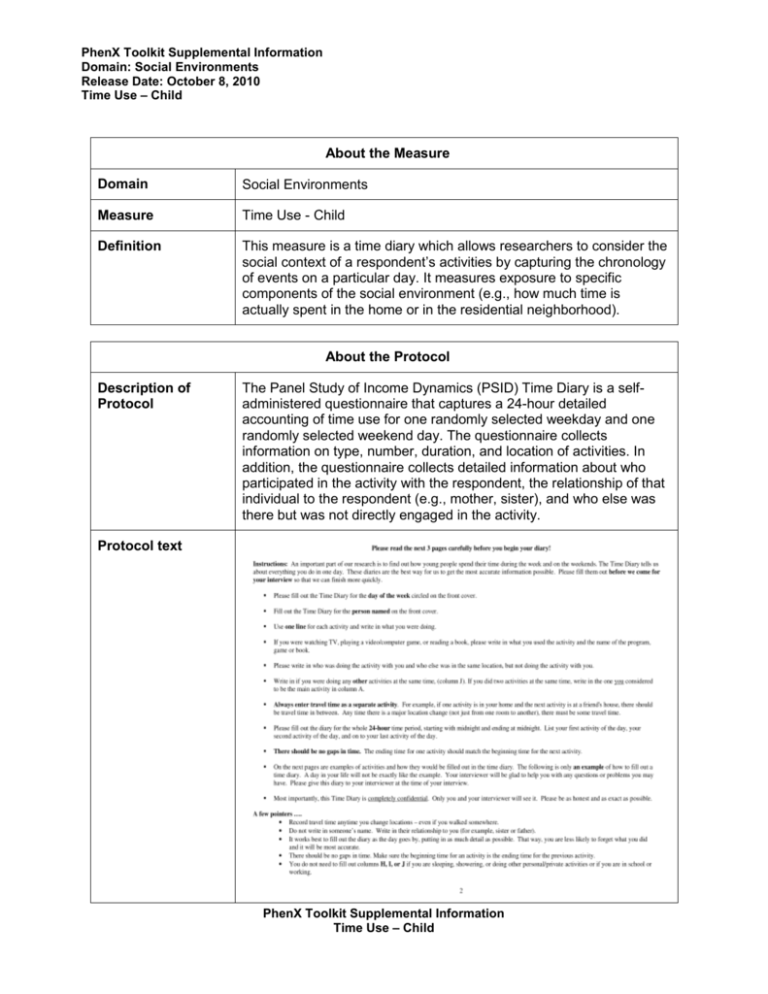
PhenX Toolkit Supplemental Information Domain: Social Environments Release Date: October 8, 2010 Time Use – Child About the Measure Domain Social Environments Measure Time Use - Child Definition This measure is a time diary which allows researchers to consider the social context of a respondent’s activities by capturing the chronology of events on a particular day. It measures exposure to specific components of the social environment (e.g., how much time is actually spent in the home or in the residential neighborhood). About the Protocol Description of Protocol The Panel Study of Income Dynamics (PSID) Time Diary is a selfadministered questionnaire that captures a 24-hour detailed accounting of time use for one randomly selected weekday and one randomly selected weekend day. The questionnaire collects information on type, number, duration, and location of activities. In addition, the questionnaire collects detailed information about who participated in the activity with the respondent, the relationship of that individual to the respondent (e.g., mother, sister), and who else was there but was not directly engaged in the activity. Protocol text PhenX Toolkit Supplemental Information Time Use – Child PhenX Toolkit Supplemental Information Domain: Social Environments Release Date: October 8, 2010 Time Use – Child A day in the life of Brian, a 16-year-old teenager . . . 1. Brian’s weekday begins at 7:10 a.m., when he wakes up to get ready for school. Since the Time Diary day began at midnight, Brian records that he was “Sleeping” from midnight until 7:10 a.m. in Column A, the primary activity column. After pressing snooze twice, Brian finally gets out of bed at 7:20 a.m. and hops in the shower. For personal or private activities, such as sleeping, showering, using the bathroom, etc., Columns H–J do not need to be completed. After a quick shower, Brian gets dressed and goes to the kitchen for breakfast. 2. From 7:40 a.m. until 7:55 a.m., Brian joins his mother and his sister, Liz, for breakfast. Notice that he records the word “Sister” in Column H rather than writing “Liz.” To ensure accuracy and avoid any confusion, you should always record the relationship you have with the person(s) you are talking about rather than his or her name. Since his family also uses this time to catch up on the news, he is sure to record “watching TV” as his secondary activity (Column J). Brian primarily is involved in eating breakfast and is only watching TV as an activity to do while eating. He also writes in the name of the news show they are watching, Good Morning America, and says where he is. Since nobody else is in the house with them, Column I is crossed out. 3. At 7:55 a.m., Brian drives himself to school. As mentioned before, travel time MUST be recorded when going from one place to another. The only time this is not necessary is when the two locations are within the same structure. For example, Brian did not record travel time from his bedroom to his kitchen and will not record travel time from the Oriental Express restaurant in the mall to the Abercrombie & Fitch store in the same mall. While he is driving, he listens to a CD and records this as a secondary activity. 4. Brian arrives at high school at 8:05 a.m. and has classes until 2:35 p.m. As with personal/private activities, Columns H–J do not need to be completed when the primary activity is “In school,” “Attending classes,” “Working,” or “At work.” Once school is over, he runs over to the track field with some of his teammates to change and get ready for practice. Practice starts at 3:00 p.m. and lasts until 4:15 p.m. Because his coaches are strict, Brian is not allowed to do anything else during practice, so his secondary activity is crossed out. After practice, he drives home to eat and shower. 5. Brian arrives home to an empty house at 4:25 p.m. He fixes himself a quick meal and also uses his Blackberry to chat with his friends and check his e-mails while he eats. He records the software he uses, AIM (AOL Instant Messenger). When he is done eating, his sister PhenX Toolkit Supplemental Information Time Use – Child PhenX Toolkit Supplemental Information Domain: Social Environments Release Date: October 8, 2010 Time Use – Child comes home, and he stays on his Blackberry to keep chatting and to play a couple computer games online. At 5:20 p.m., he gets in the shower to clean up. After his shower, his mom comes home, and he gets a phone call from one of his friends, Emily; they are deciding to meet up at the mall in a few hours, and she needs a ride. Brian records “Talking on Phone” as his primary activity, and although his friend Emily was not there in his house, she was still part of the activity because he was talking to her, and this is recorded in Column H. He also puts his secondary activity as “Making plans” to make it more clear what the phone conversation was about. Brian starts on his homework, using his computer to help him with a presentation, and quits around 7:05 p.m. to go and pick up Emily. 6. Since Brian makes two separate trips—one to go get Emily, and one to go to the mall—he records each separately. Again, Brian specifies he is picking up a “Friend,” not “Emily.” They arrive at the mall at 7:25 p.m. and stay until 9:00 p.m. Although Brian and his friends do many different things at the mall, including shopping and eating, the primary purpose of the entire trip was to serve as a social event, so he records “Socializing” as his primary activity and lists the more-specific activities as secondary. Then, Brian records the two trips home—one to drop off Emily, and then one to drive to his house. 7. When he gets home, he talks with his mom about their days. Brian tells her about his homework presentation, and she gives him some advice and agrees to help him a bit with his project. They move to the computer room and work together for the next hour. Brian records that his mom was doing the activity with him (Column H) and writes down the software they used. Once they decide the presentation is OK, Brian decides to watch a little television before bed. 8. At 11 p.m., Brian decides it’s time to go to bed, and “Sleeping” is recorded for the remainder of the day. The day is over at midnight. PhenX Toolkit Supplemental Information Time Use – Child PhenX Toolkit Supplemental Information Domain: Social Environments Release Date: October 8, 2010 Time Use – Child PhenX Toolkit Supplemental Information Time Use – Child PhenX Toolkit Supplemental Information Domain: Social Environments Release Date: October 8, 2010 Time Use – Child PhenX Toolkit Supplemental Information Time Use – Child PhenX Toolkit Supplemental Information Domain: Social Environments Release Date: October 8, 2010 Time Use – Child Participant Children, aged 5–18 years old Source Institute for Social Research, University of Michigan. Panel Study of Income Dynamics. Time Diary. Language of Source English Personnel and Training Required None Equipment Needs The respondent will need copies of the Time Diary (one for each day). Protocol Type Self-administered questionnaire General References Belli, R. F., Stafford, F. P., & Alwin, D. F. (2009). Calendar and Time Diary: Methods in life course research. Thousand Oaks, CA: Sage. Boone, J. E., Gordon-Larsen, P., Adair, L. S., & Popkin, B. M. (2007). Screen time and physical activity during adolescence: Longitudinal effects on obesity in young adulthood. International Journal of Behavioral Nutrition and Physical Activity, 4, 26. Carlstein, T., Parks, D., & Thrift, N. (Eds.). (1978). Timing space and spacing time: Human activity and time geography (Vol. 2). New York: John Wiley and Sons. PhenX Toolkit Supplemental Information Time Use – Child PhenX Toolkit Supplemental Information Domain: Social Environments Release Date: October 8, 2010 Time Use – Child Golledge, R. G., & Egenhofer, M. (Eds.). GIS and disaggregate behavioral travel modeling [Special issue]. Geographical Systems: The International Journal of Geographical Information, Analysis, Theory and Decision, 5(1–2). Goodchild, M. F., & Janelle, D. G. (1984). The city around the clock: Space-time patterns of urban ecological structure. Environment and Planning A, 16, 807–820. Guo, G., North, K. E., Gordon-Larsen, P., Bulik, C. M., & Choi, S. (2007). Body mass, DRD4, physical activity, sedentary behavior, and family socioeconomic status: The Add Health study. Obesity, 15, 1199–1206. Janelle, D. G., Goodchild, M. F., & Klinkenberg, B. (1998). The temporal ordering of urban space and daily activity patterns for population role groups. Geographical Systems: The International Journal of Geographical Information, Analysis, Theory and Decision, 5(1–2), 117–137. Kwan, M.-P. (1999). Gender and individual access to urban opportunities: A study using space-time measures. Professional Geographer, 51, 210–227. Kwan, M.-P. (2000). Analysis of human spatial behavior in a GIS environment: Recent developments and future prospects. Journal of Geographical Systems, 2(1), 85. Nelson, M. C., & Gordon-Larsen, P. (2006). Physical activity and sedentary behavior patterns are associated with selected adolescent health risk behaviors. Pediatrics, 117, 1281–1290. PhenX Toolkit Supplemental Information Time Use – Child

